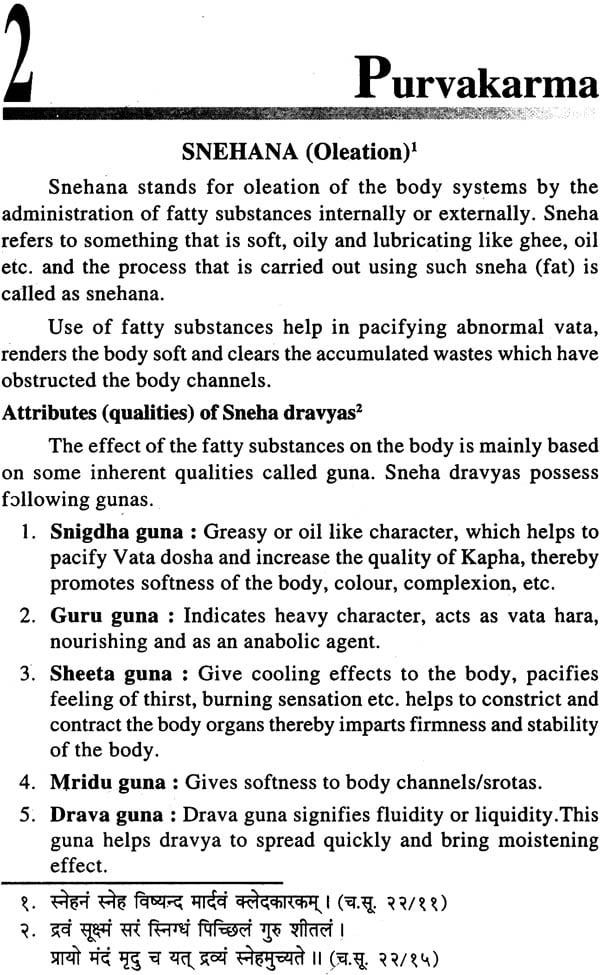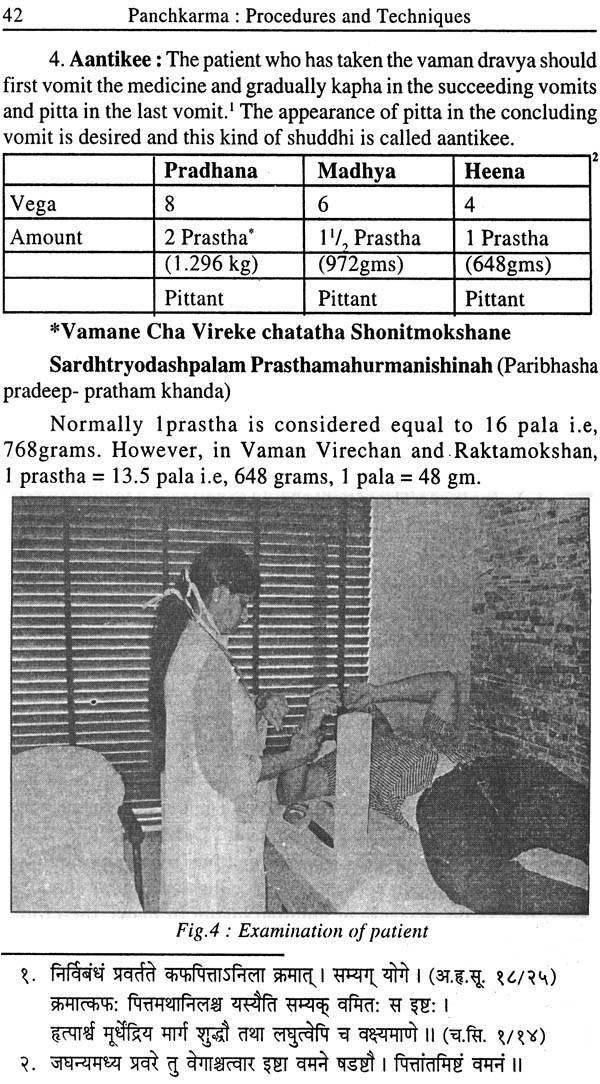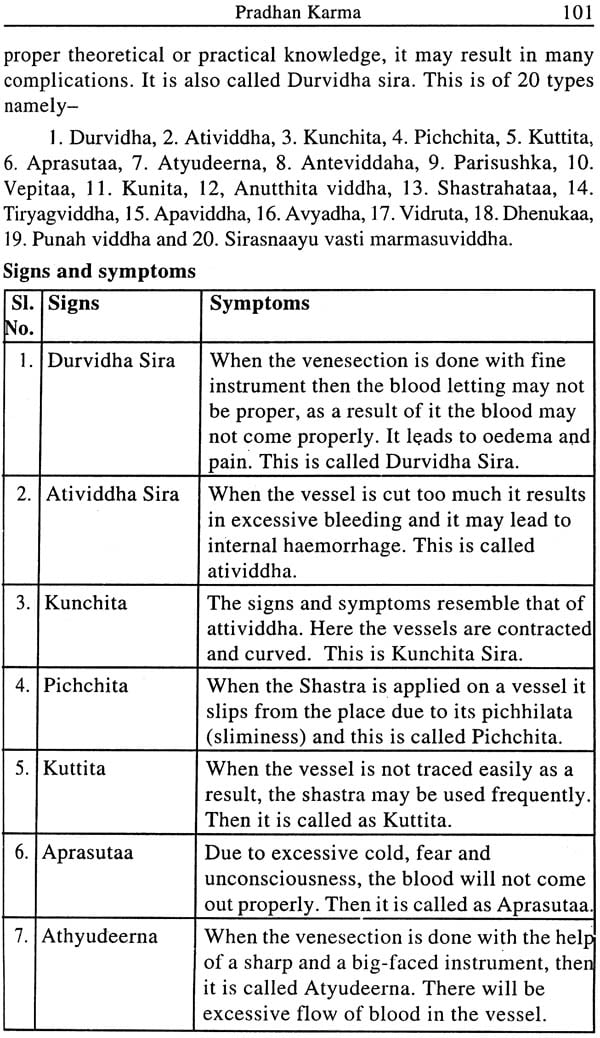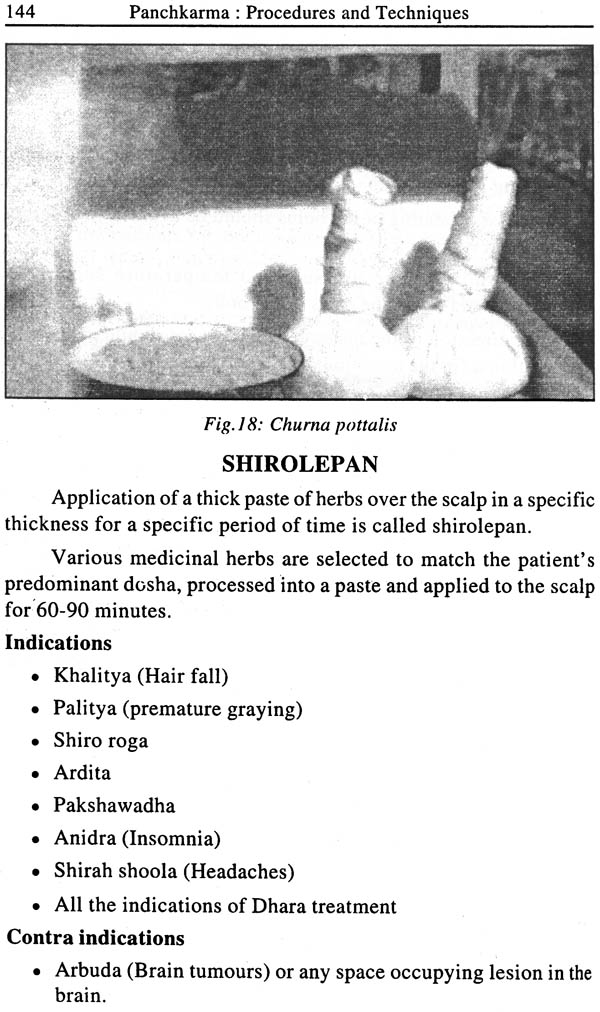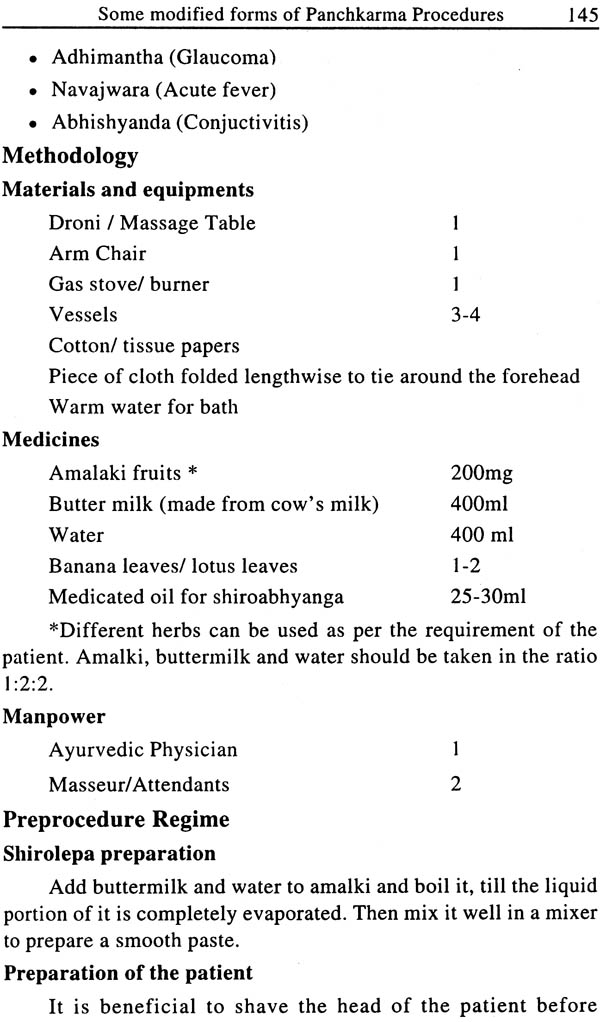
Panchkarma (Procedures and Techniques)
Book Specification
| Item Code: | NAM007 |
| Author: | Dr. Alka Kapoor |
| Publisher: | CHAUKHAMBHA ORIENTALIA, Varanasi |
| Language: | English |
| Edition: | 2019 |
| ISBN: | 9788176373579 |
| Pages: | 180 (25 B/W Illustrations) |
| Cover: | Paperback |
| Other Details | 8.5 inch x 5.5 inch |
| Weight | 210 gm |
Book Description
Panchkarma: Procedures and Techniques, is a concise comprehension of Practical panchkarma therapy with all those indispensable details that need to be kept in mind during its clinical application for the optimum outcome. This book contains chapters on Purvakarma (pre-requisites), Pradhan karma (main procedures), Pashchat karma of classical form of Panchkarma therapy as well as modified forms of Snehana and Swedana therapy popularly known as Keraliya Panchkarma covering important aspects as types, pre procedure regime, mode of administration; precautions to be taken; indications contraindication; signs and symptoms of proper administration; complications and their treatment and post procedure regimen etc. in an easily perceivable language for the first reading of informal seekers, students as well as physicians interested in practicing various Panchkarma procedures.
Dr. Alka Kapoor BAMS MD PGDHA graduated from A & U Tibbia College, New Delhi, India. She did her post graduate studies in Ayurvedic medicine (Kayachikitsa) from MMM Govt. Ayurvedic College, Udaipur.
Competent Medical Practitioner and Academician with more than 10 years of quality experience in Kayachikitsa and Panchkarma and Research and Development pertaining to Ayurveda. Deft at diagnosing and treating the diseases based on the principles of body, mind, and spirit and prescribing appropriate treatment through Panchkarma, Diet and Lifestyle Counselling, Psychosomatic Analysis and Ayurvedic Medicine.
She has worked with several organizations and headed Panchkarma centres as well. Proficient in coordinating with a diverse range of departments, professionals, and programs through a complete understanding of the Ayurveda healthcare arena and integrated networks.
Presently she is working with one of the Apex institute of Ayurveda, All India Institute of Ayurveda, New Delhi.
It is a pleasure to find that a concise yet authentic and dependable work is being published on Panchkarma. This book appears to be written with a view to impart simple and basic knowledge of Panchkarma procedures to the learners.
Panchkarma is a very vast and unique concept of Ayurveda. In fact, Ayurveda is the only medical science which conceptualizes the process of cleansing even at cellular level through the Panchkama therapies. These therapies transformed Ayurveda’s approach for prevention as well as treatment to diseases.
Though there are different schools of thoughts, but in a nutshell classical form of Panchkarma encompasses the five procedures viz., Vaman, Virechana, Vasti, Nasya, Raktampkshana. Due to extensive preparatory regimens, exhaustive precautions and various misinterpretations and myths associated with the procedures; many Ayurvedic practitioners refrain from practicing classical form of Panchkarma procedures. However, it has been observed that minor details and the precautions as explained with each procedure, if followed properly, a practitioner can very well achieve success in the procedure to get best result of the treatment as explained in classical texts of Ayurveda.
Considering this fact, I would like to appreciate the author of this book, Dr. Alka Kapoor as she has endeavoured to pick up all those considerations and ‘to be followed’ things which can help students and busy practitioners who are willing to do the procedures as per classics but cannot do exhaustive reading of lengthy texts. The author has taken pains in pooling the relevant information in simplified form.
I believe that this book will serve as ready reckoner for students, practitioners, research scholars, academicians and will surely facilitate in establishing a good Panchkarma centre for better healthcare services.
I congratulate Dr. Alka Kapoor for this achievement and contribution to Ayurvedic literature and wish her luck for all future endeavours.
This book on Panchkarma therapies is a concise knowledge of various Panchkarma procedures with those essential details that need to be kept in mind during its clinical application for the optimum outcome.
While learning this science and during several years of my clinical practice, I always felt the need of an handbook on Panchkarma which is easy to understand, practical to apply, handy to refer and yet authentic in approach in terms of minute details explained in the classical texts regarding several procedures involved in it.
Our Acharyas have explicitly explained each and every step of this science like who all should be subjected to any particular therapy, what is the best time and duration, doses of medications used, and even the direction of application of any medicine and the thickness to which it needs to be applied, in case of local application, all has been described in the texts. Hence practically if we are not able to follow these specifications, we may not be able to get the desired outcome of our treatment.
This thought infact inspired me to do this work, which actually is a compilation of essentials of practical panchkarma therapy in an easily perceivable language for the first reading of informal seekers, students as well as physicians interested in practicing Panchkarma. Hence this presentation involves more of tables and pointers.
This book is presented with chapters on Purvakarma (prerequisites), Pradhan karma (main procedures), Pashchat Karma covering important aspects as types, pre procedure regime, mode of administration; precautions to be taken; indications contraindications; signs and symptoms of proper administration; complications and their treatment and post procedure regimen etc.
Some of the modified forms of snehana and swedana karma have also been included which are in vogue now a days as Keraliya panchkarma owing to their simplicity, relatively easy administration and better patient compliance viz., Dhara karma, kaya seka (pizichil), panda sweda, shirolepa etc. it is expected that in addition to the palliation of the disease and underlying doshik vitiation, these procedures help in elimination of doshas through transdermal mobilization, thus liberating the microchannels of stagnation and leading to uninterrupted flow of nutrition through them.
It is hoped and believed that this small effort will prove to be of some benefit to the prospective readers to know more about this inimitable concept and practicing physicians to confiscate their doubts and prepare them to carry out Panchkarma in patients with a bit increased level of confidence.
Ayurveda, “the science of life”, is the most ancient system of medicine in the world having the potential in preventive, promotive and curative aspects.
It is a system of medicine with sound fundamental principles which are the outcome of continuous efforts and thousands of years of experience, experimentation and wisdom of ancient sages. In spite of its antiquity going back to Vedas, which are the oldest recorded wisdom on the earth, it continues to be pertinent even today both conceptually and practically.
The definition of health as given by WHO, is not merely absence of any disease but it is a state of physical, mental, social and spiritual well-being. This is given by ancient Acharayas in Ayurvedic text about three thousand years ago, as
”Samdoshah samaagnishch samdhatu malah kriyah.
Prasannatmendriyemanah swasthityabhidiyate.”
Ayurveda has been able to maintain its glory and sustain its relevance beyond time and space is due to the fact that it is practiced on the laws of nature and not merely on tentative rules of medicine. This vast science embraces within its folds a number of unique concepts; principles and therapeutic approaches, which if merged with the conventional medicine; the word medicine may appear stronger and appropriate.
Ayurveda pioneers a distinctive approach of two fold intervention in therapeutics namely Samshodhana or cleansing/Bio-purification and Samshamana or pacification. It is the only system of medicine in the world, which recommends the requirement of carrying out cleansing of biological system from gross channels up to the micro channels at molecular levels intending to clean the entire organism which in turn can enable it for self-recovery and enhanced responsiveness to medicines. The purification therapy is described classically in terms of Samshodhana and Panchkarma i.e, Vamana, Virechana, Vasti, Nasya & Raktamokshan.
These Panchkarma measures have been applied in almost all diseases described in Ayurvedic classical and has been claimed that this fivefold therapy affords the permanent cure and besides their curative role, these therapies have also been used in prevention of diseases. Along with other forms of drug and non-drug treatment this therapy is used for the cure of the chronic diseases such as rheumatic diseases, paralysis, chronic bronchitis, asthma, colitis lipid disorders and certain mental diseases.
Keeping such manifold advantages of Panchkarma therapy and growing global interest in Ayurveda, this book is introduced describing the important aspects of this unique therapy.
Panchkarma Therapy : An Overview
Panchkarma is an imperative & integral component of Ayurveda which is testified by the fact that it is essentially applicable to all cases covering wide range of preventive, curative and promotive conditions. It is basically a purificatory regimen, which enhances the acceptability of body to various therapeutic procedures. It is commonly said that as dyeing is not adequately effected if the cloth is not properly cleaned. Similarly medicines or Rasayanas cannot produce the desired effect if the body is not cleansed properly. This therapy is believed to impart radical elimination of disease causing factors and maintain the equilibrium of doshas.
The measures for bio cleansing or purification is described in the classical texts as Samshodhana and Panchkarma. The term Panchkarma is mostly used in Charak Samhita which includes following five procedures
1. Vamana (Emesis)
2. Virechana (Purgation)
3. Anuvasana (Oil enema)
4. Asthapana (Decoction enema)
5. Shirovirechan/Nasya (Nasal insufflations)
However, Rakta mokshan is enumerated as one of the Samshodhanas in Sushruta Samhita and Ashtanga Hridaya. Hence another school of thought considers Rakta mokshana as one of the measures of this five fold therapy and includes Anuvasana and Asthapan vasti together in one head Vasti, thus keeping the number unchanged as under
1. Vamana (Therapeutic Emesis)
2. Virechana (Therapeutic Purgation)
3. Visti (Therapeutic Enemata)
4. Shirovirechan/Nasya (Nasal insufflations)
5. Raktamokshana (Therapeutic Bloodletting)
Prior to these actual five procedures, preparatory measures i.e., Purva Karmas are done. These include—
1. Pachan (administration of digestive medicines to enhance the process of digestion and reduce the production of undigested metabolic byproducts known as Ama)
2. Snehana (Oleation)
3. Swedana (Fomentaion/Sudation).
After the actual procedures, Samsarjana Krama is done as post Panchakarma measure in which post procedural specific diet and lifestyle regime is advocated to the patient who is then followed by Rasayan therapy or Shaman chikitsa.
Suitable Season for Panchkarma
It is generally said that seeds if not grown in appropriate season don’t grow properly. Similarly if the treatments are not done at the right time, they barely bring results.
Moderate weather conditions when there is neither extreme hot nor extreme cold or rains with clear sky are considered appropriate to carry out Panchkarma. These therapies should be avoided in peak summers, winters and rains. Accordingly Vasant (spring season), sharad (autumn) and Pravritta (Season prior to heavy rains- premonsoon) are considered best for carrying out Panchkarma. Months corresponding to these seasons include Chaitra (mid February to mid March), Margsheesh (mid October to mid November) and Shravan (Mid July to Mid August).
Vitiation of Kapha Dosha occurs in Vasant Ritu, Pitta in Sharad ritu and Vata in Pravritta ritu. Hence Vaman is indicated in Vasant ritu, Virechan and Raktamokshan in Sharad ritu and Vasti in Pravritta ritu.
If the case in not emergent, it is always advisable to wait for the proper season. However in cases of serious and emergency conditions, necessary treatment can be done regardless of any season with due caution to protect the patient from unusual cold, heat, rain and mist.
| 1 | Introduction | 1-7 |
| Panchkarma Therapy: an Overview | ||
| 2 | PurvaKarma | 8-35 |
| Snehana | 8 | |
| Swedana | 26 | |
| 3 | PradhanKarma | 36-112 |
| Vamana | 36 | |
| Virechana | 52 | |
| Vasti (Medicated enema) | 61 | |
| Anuvasana Vasti | 63 | |
| Niruha/Asthapan Vasti | 66 | |
| Uttar Vasti | 79 | |
| Nasya (Nasal insufflation) | 81 | |
| Raktamokshana | 90 | |
| Prachchhana Vidhi | 103 | |
| Shringavacharana Vidhi | 108 | |
| 4 | Pashchat Karma | 113-116 |
| Samsarjana Krama | 113 | |
| 5 | Some Modified forms of Panchkarma Procedures | 117-156 |
| Dhara Karma | 117 | |
| Shirodhara, Sarvanga Dhara, Ekanga Dhara | 121 | |
| Kaya seks (Pizichil) | 126 | |
| Shashtika Shali Pinda Sweda (Navara Kizhi) | 131 | |
| Anna Lepa | 135 | |
| Avagaha Sweda | 135 | |
| Patra Pinda Sweda (Ela Kizhi) | 137 | |
| Choorna Sweda (Podi Kizhi) | 143 | |
| Shirolepan | 144 | |
| Shirovasti | 146 | |
| Kati Vasti | 150 | |
| Akshi Tarpana | 153 | |
| 6 | Guidelines for Panchkarma Centres | 157-164 |
| Man Power | 158 | |
| Infrastructure | 158 | |
| List of minimum essential equipments required for a Panchkarma theatre | 158 | |
| Other Requirements, etc. | 158 | |
| 7 | Annexure-A | 165-166 |
| List of medicine commonly used in Panchkama therapy | 165 | |
| 8 | Annexure-B | 167-169 |
| Weights and Measures | 167 | |
| Bibliography | 170 |
